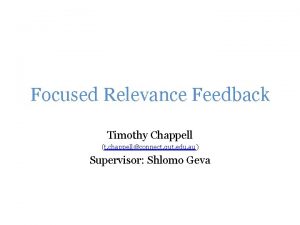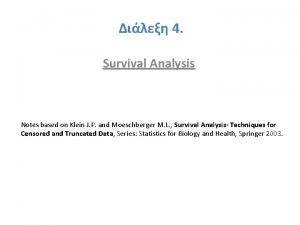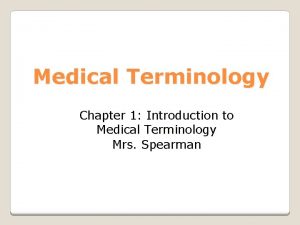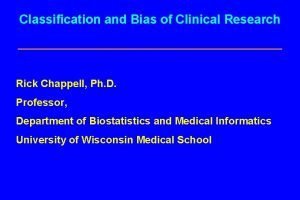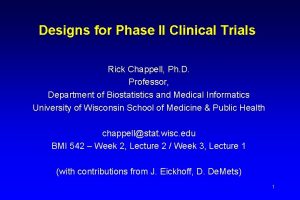Survival Analysis Introduction and Terminology Rick Chappell Ph












- Slides: 12

Survival Analysis – Introduction and Terminology Rick Chappell, Ph. D. Professor, Department of Biostatistics and Medical Informatics University of Wisconsin School of Medicine & Public Health chappell@stat. wisc. edu BMI 542 #1

Survival Analysis Introduction • Concerned about time to some event • Event is often death • Event may also be, for example 1. Cause-specific death 2. Recurrence of tumor or death, whichever comes first 3. Death or some non-fatal event 4. Release from hospital; marriage; divorce; job tenure; job acquisition … #2

Fundamental Features of Survival Analysis - Loss to followup (right censoring) - Interest in conditional inference: given survival to time t, what is a patient’s risk? Fundamental Assumption of Survival Analysis - Censoring is independent of failure #3

Subject o 1 2 * Failure • 3 4 * Administrative Censoring Loss to Follow-up Failure T 0 Follow-up Time (T years)

Questions We May Want to Address • What is the probability of 5 -year survival? • What is the probability of “X”-year survival, for all X (within the range of the data)? • What is the median survival (if it exists)? • Is one group’s survival larger than another’s? • Can we create a regression to model survival as a function of predictors – not just treatment group but age, biomarkers. . . ? #5

Terminology 1. Origin (baseline): time from which events are measured. • Time of randomization, if applicable • Otherwise time of “registration” • In observational studies it may be birth 2. Time scale: time (t) since origin. 3. Right censoring: largest time at which patient is known to be “alive”. #6

Terminology 4. Left censoring: smallest time before which patient is known to be alive (not discussed). 5. Interval censoring: pair of times between which patient is known to fail (not discussed). 6. Left truncation: in observational studies, the time at which the patient comes under observation (not discussed). #7

Terminology 7. Survival Curve: S(t) = Probability of survival past t. 8. Hazard function – has units, eg. per year: h(t) = l(t) = slope of S(t)/S(t) = “conditional risk at t” = “instantaneous force of mortality at t”. Given that I have survived to time t, how much danger am I in? #8

Constant hazard: h(t) = a, S(t) = e-a. Exponential distribution; Useful in physics (radioactive decay); Not applicable in medicine except as a gross approximation. #9

Terminology 8. Positive Aging: h(t) increases with t; For human mortality, h(t) ~ t 4. 9. Negative Aging: h(t) decreases with t; 10. Nonmonotone hazard: h(t) goes up then down, or down then up, or. . . #10

#11

Annual hazard in U. S. , 2003 #12
 State of survival survival of the fittest tweak
State of survival survival of the fittest tweak State of survival survival of the fittest stages
State of survival survival of the fittest stages Helen yetter chappell
Helen yetter chappell Timothy chappell qut
Timothy chappell qut Maggie chappell
Maggie chappell Survival skills introduction
Survival skills introduction Survival analysis vs logistic regression
Survival analysis vs logistic regression Partitioned survival analysis
Partitioned survival analysis Survival analysis klein
Survival analysis klein Survival analysis part ii
Survival analysis part ii Medical terminology learning exercises chapter 1
Medical terminology learning exercises chapter 1 The word root athr means ________
The word root athr means ________ Ileum and ilium
Ileum and ilium



